Is your incubation ability worthy of help?
Editor’s note: This article comes from WeChat public account “autocarweekly” (ID: autocarweekly) , By Karakush.
The hope of the whole village
Since the market value of Tesla has jumped over 100 billion, becoming the second largest auto company in the world, its future is no longer just about the individual destiny of the company, but also represents a possibility of the entire traditional car- Is your incubation ability worthy of help?
The answer is always ambiguous.
This ambiguity is partly due to the fact that buddies are expanding rapidly and quickly, but the foundation is not very reliable.
For example, it raised another $ 2 billion in funding last week.
On February 13, Tesla announced the issuance of $ 2 billion worth of new shares, priced at $ 767, which is 4.6% lower than the closing share price on the day. The discount is 10 times stronger than the last issue in May last year.
In fact, from 2011 to 2019, Tesla made six additional offerings with pricing discounts within 1%. This should be the biggest discount Tesla has given in ten years.
Wall Street is shocked.
After all, Musk told the earnings conference only two and a half weeks ago that it didn’t sound wise to dilute the company’s equity. Speaking on the front foot and slap on the hind foot. Of course, the stock price is much lower when speaking, only at $ 580.99 (as if I can afford it).
Since then, Tesla’s stock has increased by nearly 38%; this year it has grown more than 86%. Cyclonus advances are a prerequisite for buyer discounts right now.
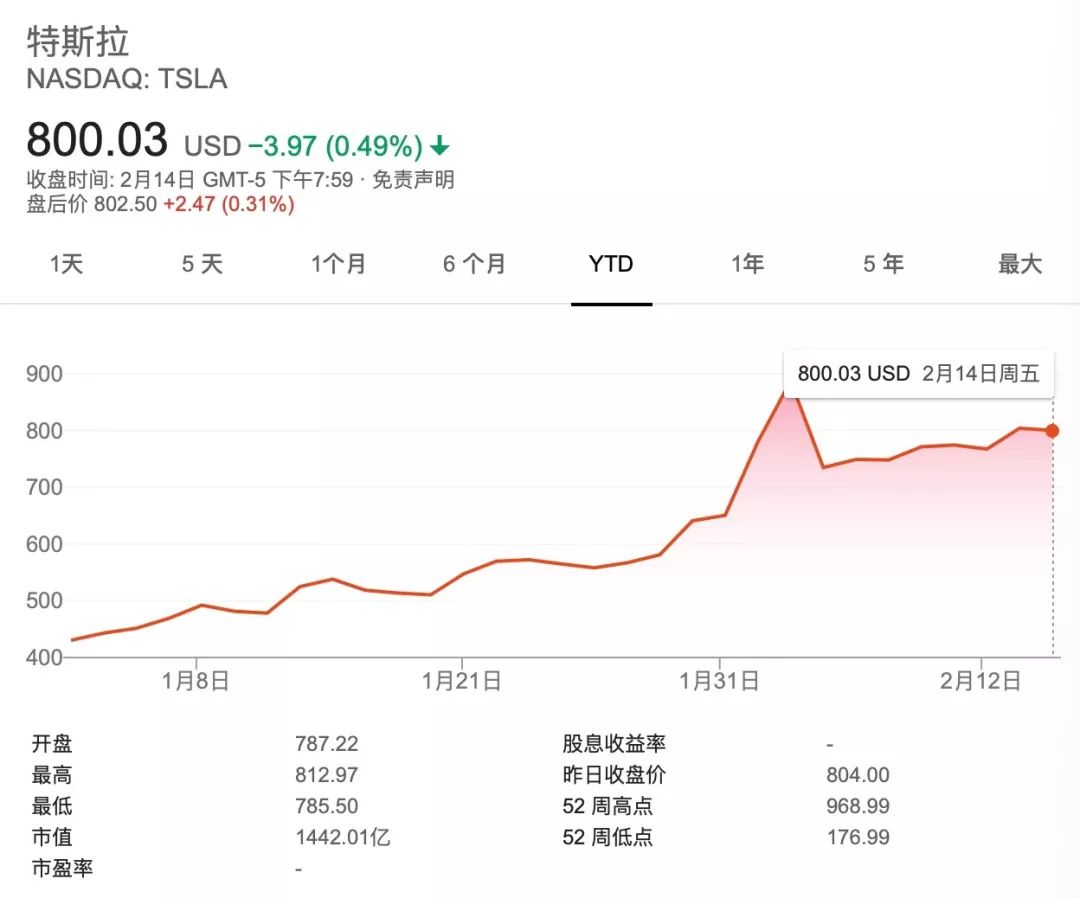
Big money deserves more attention than equity. In order to continue its rapid expansion, it also improves its ability to resist risks. Capital markets generally recognize Tesla’s trade-offs. At the close last week, its stock price remained stable at $ 800 with a market value of $ 144.2 billion.
But there are also worries and inconsistencies, does it mean that Tesla’s operations are not as reassuring as claimed, especially considering that its cash needs are not controllable.
Although Tesla had cash and equivalents of US $ 6.3 billion at the end of the fourth quarter of last year, and achieved profit for two consecutive quarters, it was free for three consecutive quartersThe cash flow is positive; however, it is worth noting that its consumption capacity in a quarter is also as high as $ 1.4 billion.
Companies should raise funds when they can, not when they need them. The Wall Street Journal commented on Tesla in this way, although it was more relaxed in other companies.
Like Apple.
In September last year, Apple issued debts and raised $ 7 billion. Of course, it was not because of lack of money. Apple’s book cash and investment securities totaled more than $ 200 billion. Its debt is mainly aimed at low interest rates at that time, financially cost-effective. It’s like high-end people don’t buy a house for dwelling, but they put financial products in a bowl.
Comparing with Apple now, it is too bullying; even with the development stage presets, Tesla may never reach the scale that the IT circle or Internet circle can achieve. After all, cars are at their peak and their market value is only $ 228.415 billion.
But in terms of temperament, Tesla is already a Silicon Valley trust. And this may be a trend of further upgrading of the rim in the future.
Micro-quasi-monopoly
For example, in terms of main business, Tesla has almost realized a quasi-monopoly at the micro level.
Last year, the global total sales of new energy vehicles was about 2.21 million. Tesla’s three models together accounted for nearly 17%.
You might think that the numbers are so skinny, and the numbers are still a bit weak. There are indeed companies that can completely dominate their field, such as IBM and Microsoft more than ten or twenty years ago.
But absolute monopoly is rare today. For example, in the mobile phone industry, the top three vendors last year were Samsung, Huawei, and Apple, with shares of 21.6%, 17.6%, and 13.9%, respectively.
It’s not the same thing in the automotive field. With reference to last year’s broad market, the world’s cumulative new car sales were 90.3 million units, ranking first in the Volkswagen Group, with sales of nearly 11 million units, accounting for 12%. In the local market, the proportion may be higher. For example, in the Chinese market, the masses of the North and the South together account for nearly one fifth.
The fundamental difference comes from market maturity and full competition.
For example. In the 1950s, the largest American car company was General Motors, which was at its peak and controlled half of the US auto market; meaning that the other half of consumers bought cars from GM competitors.
50% can be regarded as a historical threshold for market share. Outside of the macroeconomic boom, the deadly Japanese cars had not yet come in. A blessed environment cannot be copied. Today, GM is still the largest car company in the United States, but its control of the market has been reduced to less than 20%.
It is very difficult to reach a large monopoly. According to statistics from CleanTechnica, Tesla’s deliveries in the US last year accounted for 78% of the US pure electric vehicle market.
On the one hand,It is clear that the current competition in the electric vehicle industry is probably not enough; on the other hand, it is undeniable that Tesla is really powerful.
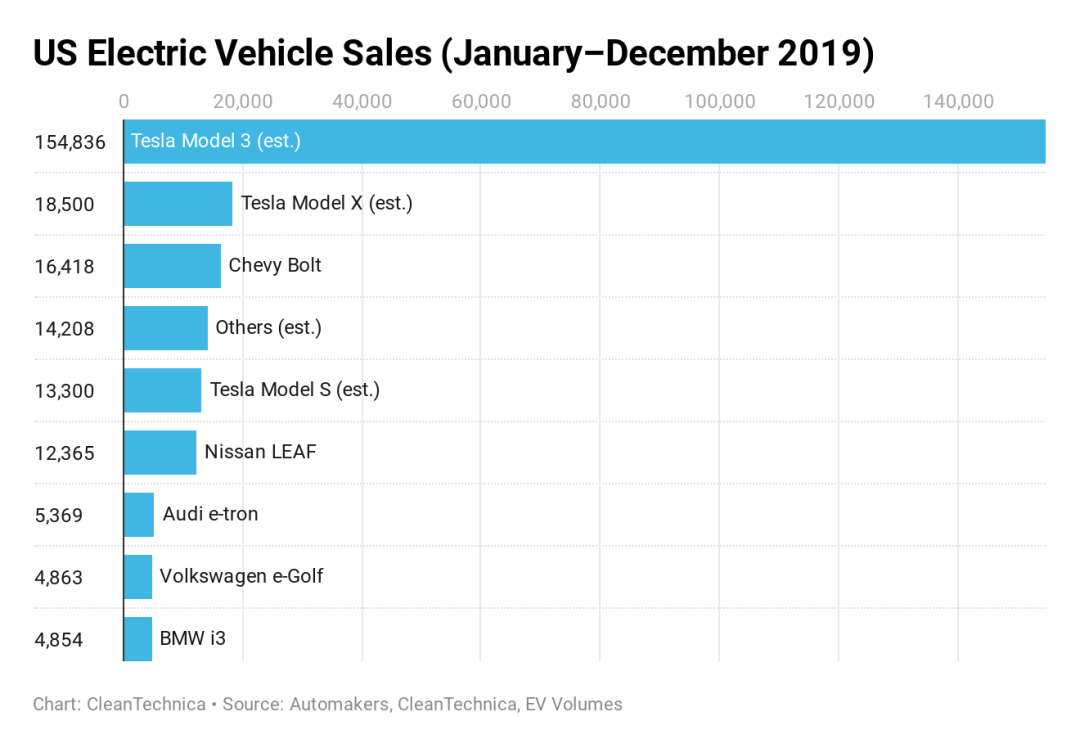
(Tesla is not without competitors. Just on the map you can see GM, Nissan, Volkswagen, BMW and others.)
Actually, tech giants including Google, Apple, Netflix, Amazon, and others who are suspected of monopolizing all have competitors. The significance of monopoly is that the market share is sufficient to allow you to control the industry’s right to speak to a certain extent, and thus implement the monopoly’s pricing power.
These Silicon Valley quasi-monopolists have a routine to quickly rise to power. And Tesla took almost every step.
The first is timing. Like Amazon. When it was established, it took advantage of the fact that most traditional retailers did not know what kind of hammer the Internet was, and it was extremely pessimistic and seriously worried about payment security.
The second is advanced products. Google, for example. When it came out, there were already several mature search engines. In fact, some experts believed that the search technology at that time was quite mature; until Google proposed a new algorithm with more powerful functions.
Together these two points have achieved Tesla’s similar era advantage.
Until three years ago, mainstream car companies’ strategies for electric vehicles were still “low risk, low investment.” At the time, Bellenberg had analyzed and pointed out the gap. In five years, Tesla invested nearly 32.7 billion US dollars in electric vehicle projects, which is 40% more than Daimler and Volkswagen combined.
This gap explains the past year when traditional car companies launched this and that, but the product did not reflect any mammoth technology accumulation.
It was not until the end of last year that there was a major counterattack. For example, the Volkswagen Group announced that it will invest at least 60 billion euros in 5 years for the research and development of electrification and digital next-generation technologies, of which about 33 billion euros will be invested in pure electric vehicles. It is expected that at least 75 pure electric products will be launched by 2029. Cumulative sales reached 26 million.
This may be a turning point.
Tesla currently has four plants worldwide, three of which are used in vehicle manufacturing, in California, Shanghai and Berlin. Musk also previewed the Texas factory in the first half of the previous two days on Twitter.
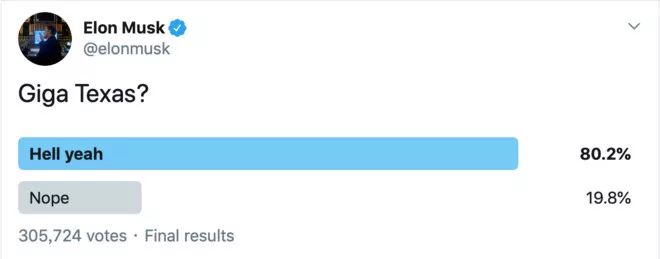
But ten years later, I don’t know what kind of system Tesla will have. At the 2018 shareholders’ meeting, Musk had planned to build 10 to 12 super factories around the world.
He also said that we should open one on each continent to meet the needs of each place. Wikipedia also quoted his earlier assumption that if power were to be maintained for all humanity, 100 super factories would be needed …
And it’s not just capacity that determines the future.
Tesla is considered the most similar to Apple among all tech giants.
That’s because the latter is also one of the few players whose main business is hardware. But its real routine is a systematic ecology. Each product is a part of the ecosystem. I just launched all parts of the system to bring a smoother and more direct experience for users, and to bring more profit windows for myself.
If you look at it more broadly, it’s common to all these companies to get involved in products and services in related fields.
It’s just that Apple’s particular systemicity, let’s take it as an example. For example, Amazon is still the main player in cloud computing; Netflix is making movies on its own, and it is increasingly threatening mainstream studios; and Google provides almost everything beyond search.
In the process of rapid development, this kind of cross-border is not even an advantage worthy of boasting, but just needed, because it will be difficult for you to find suppliers from the outside that can keep up with the pace. Sometimes it is because of technical level, sometimes it is because of industry barriers, such as Netflix.

Many of these actions are often against the traditional wisdom and common sense of the auto industry. The core competence of automobile manufacturing lies in integration, and outsourcing everything else to the supplier system, because the latter is more professional.
There are similar examples in the industry, such as BYD and its proud “vertical integration”. However, in the past two years, BYD opened up external procurement because internal suppliers could not reach the optimal competition conditions, so they still had to leave the choice to a market-oriented mechanism.
Tesla is truly disruptive here. It not only makes cars but also batteries, it also provides direct sales and services, it also maintains the charging network and extends to other parts of the ecosystem, such as insurance and solar power. And they are doing very Tesla.
Silicon ValleyTrust
Someone has estimated the value of Tesla in the form of a spin-off, thinking that even if the market value exceeds 100 billion yuan, it is still seriously undervalued.
For example, its energy department sells leased solar panels / roofs / bricks and battery storage systems. Friends in China rarely understand because there are almost no installed users. But Musk attaches great importance to it. This is based on the SolarCity he had acquired by force and was aggressively promoted on Twitter the other day.
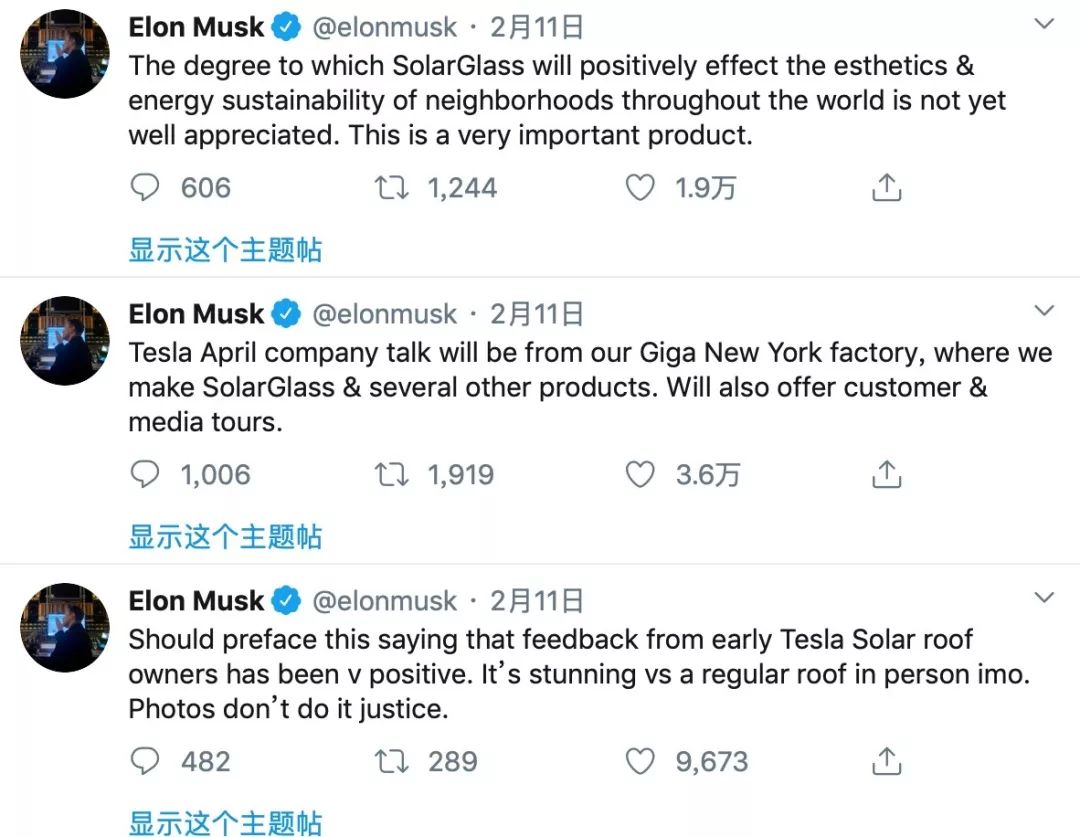
An analysis article on CleanTechnica compares this part with General Electric ’s energy sector, which has annual revenue of $ 35 billion and operating profit of $ 1.9 billion. According to the current market value of GE, which is slightly higher than US $ 112 billion, the energy business accounts for about one third. Under the benchmark, the conservative valuation of Tesla’s energy business is approximately US $ 30 billion.
But there are actually two other positive factors that Tesla has not taken into account:
On the one hand, the main business of GE Energy is the turbine business, and the installation cost will not fluctuate within ten years; however, the battery business should have a significant downward trend.
On the other hand, GE Energy has suffered a lot in the past two years. Because it missed the opportunity of renewable energy and dragged down the stock price, the overall market value is average (Last year GE was also kicked out of the Dow constituents).
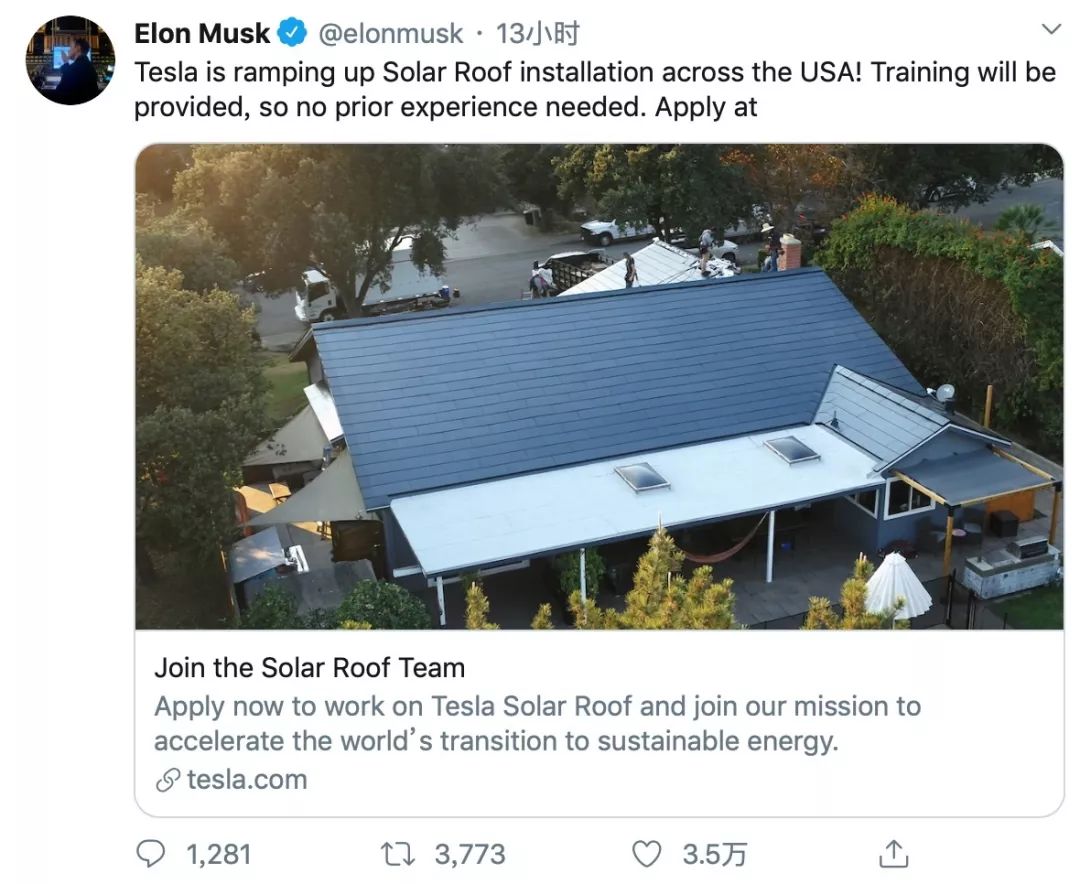
Recruitment inspiration is also a sign of expansion
For example, Tesla’s self-driving department, which we are more familiar with, has a value of more than $ 19 billion in the eyes of many investors, which is based on the valuation of Cruise Automation, an autonomous driving company, last year. Price. And if you change the benchmark, such as Google’s Waymo, according to Morgan Stanley’s valuation is about 105 billion US dollars.
Furthermore, Tesla has also become imaginative in terms of in-vehicle infotainment and software, regardless of the cost of features. Although it is only $ 10 per month, this is obviously only the beginning. New features are constantly being added, such as Tesla Theatre andSlavic arcades and more.
This means it’s creating a potential revenue stream and it’s not impossible to upgrade costs later. This is an entry point that can monopolize pricing power.
At the same time, Tesla is also acquiring small companies that help its business. Tesla’s publicly acknowledged acquisition last year was Maxwell Technologies, a battery technology company, but they actually spent $ 96 million on the acquisition.
This should include companies like DeepScale, a small company that can apply deep neural network technology to small devices. For example, the company’s Carver21 product is designed to optimize the processing of data by the front camera of autonomous vehicles. This complements Tesla’s “fully autonomous driving” technology.
Just last week, TESLARATI also found out that Tesla might have acquired SilLion, a small company specializing in high-energy batteries, through “acqui-hiring”.
This company’s special feature is the high-load silicon anode and electrode technology for commercial cylindrical batteries, which can make the battery more energy-efficient, safer, and cheaper in production. Combined with the previously acquired Maxwell, Musk’s previously guaranteed next-generation battery should not be blown up.
For the entire plate, we don’t see much now, but if Tesla’s ecological network is realized, then it may be able to control the search, smart hardware, streaming media and retail markets like today’s technology giants. Great traffic.
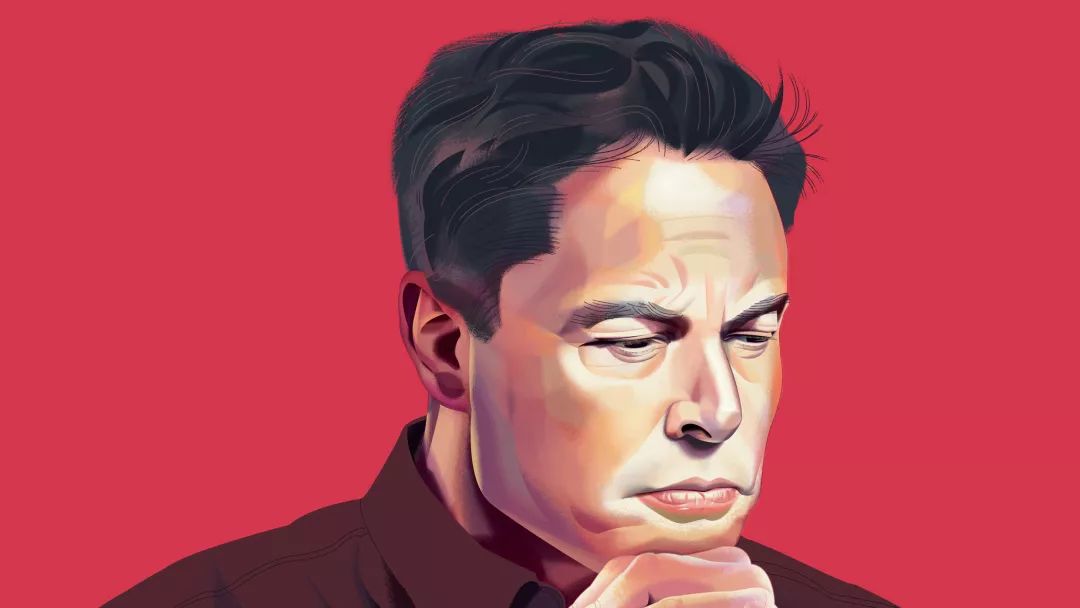
This also answers a frequently asked question recently: Is Tesla a car company or a technology company? We often try to use financial models to analyze what it is closer to, and try to characterize it.
Perhaps the key is never here.
Tesla is showing a new form of car company. What we should think about is, if other car companies want to live decently to the next era, will they not become less car companies, but try to be an all-round trust company.